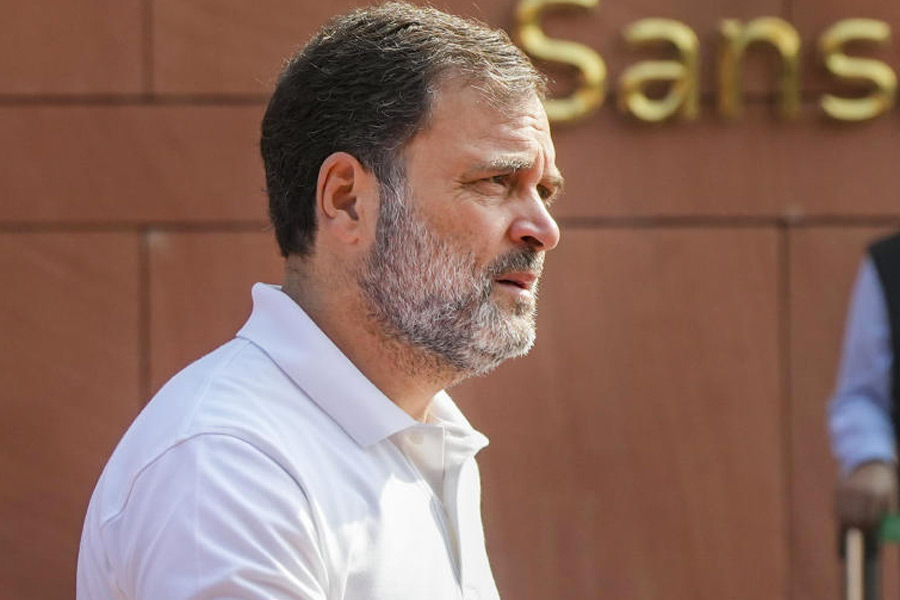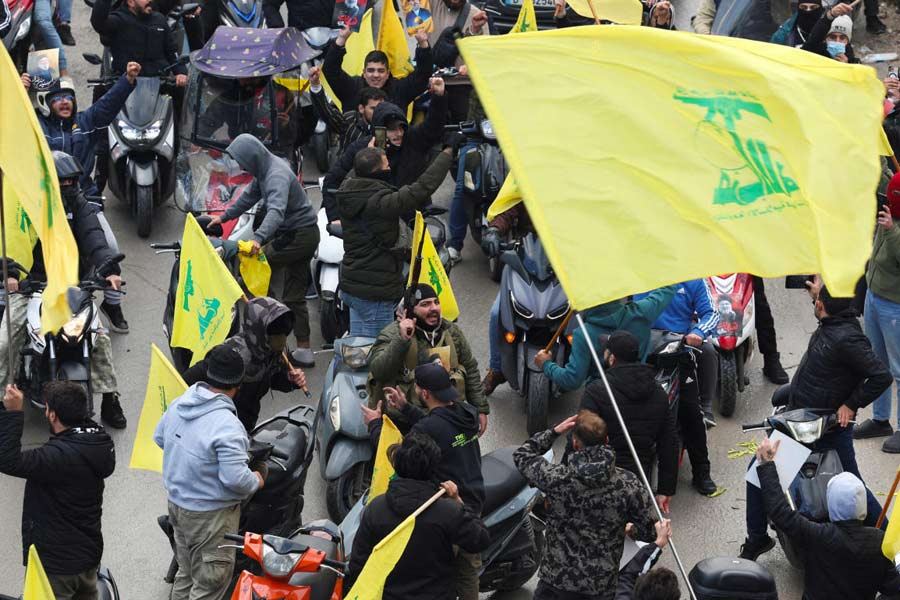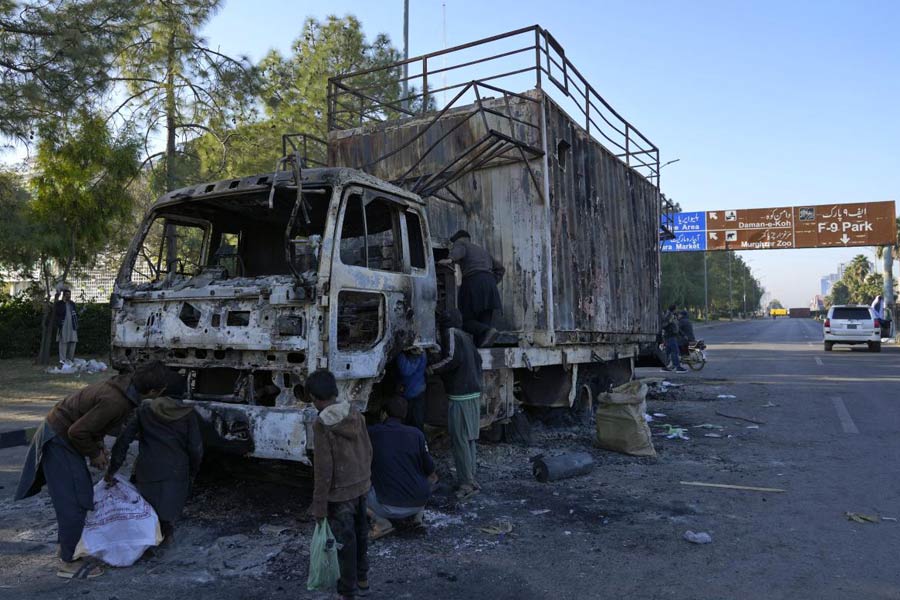The crowds surged through the gates, fought their way up the stairs of the 160-year-old station, poured across the platforms and engulfed the trains.
It was May 5, around 10am. Surat was beastly hot, 41°C. Thousands of migrant labourers were frantic to leave — loom operators, diamond polishers, mechanics, truck drivers, cooks, cleaners, the backbone of Surat’s economy.
Two of them were Rabindra and Prafulla Behera, brothers and textile workers, who had arrived in Surat a decade ago in search of opportunity and were now fleeing disease and death.
Rabindra stepped aboard carrying a bag stuffed with chapatis. His older brother, Prafulla, clattered in behind, dragging a plastic suitcase packed with pencils, toys, lipstick for his wife and 13 dresses for his girls.
“You really think we should be doing this?” Prafulla asked.
“What else are we going to do?” Rabindra said. “We have nothing to eat and our money’s out.”
They were among tens of millions of migrant workers stranded without work or food after Prime Minister Narendra Modi imposed a national coronavirus lockdown in March. By spring and summer, these workers were so desperate that the government provided emergency trains to carry them back to their home villages. The trains were called Shramik Specials, because shramik means “labourer” in Hindi.
But they became the virus trains.
India has now reported more coronavirus cases than any country besides the US. And it has become clear that the special trains operated by the government to ease suffering — and to counteract a disastrous lack of lockdown planning — instead played a significant role in spreading the coronavirus into almost every corner of the country.
The trains became contagion zones: every passenger was supposed to be screened for Covid-19 before boarding but few if any were tested. Social distancing, if promised, was nonexistent, as men pressed into passenger cars for journeys that could last days. Then the trains disgorged passengers into distant villages, in regions that before had few if any coronavirus cases.
One of those places was Ganjam, a lush, rural district on the Bay of Bengal, where the Behera brothers disembarked after their crowded trip from Surat. Untouched by the virus, Ganjam soon became one of India’s most heavily infected rural districts after the migrants started returning.
Many people in Ganjam’s villages had no idea what coronavirus symptoms were — until people around them started dying.
“There was a very direct correlation between the active Covid cases and the trains,” said Keerthi Vasan V., a district-level civil servant in Ganjam. “It was obvious that the returnees brought the virus.”
The tragic irony is that Modi’s lockdown inadvertently unlocked an exodus of tens of millions. His government and especially his Covid-19 task force, dominated by upper-caste Hindus, never adequately contemplated how shutting down the economy and quarantining 1.3 billion people would introduce desperation, then panic and then chaos for millions of migrant workers at the heart of Indian industry.
A top economic adviser to Modi, Sanjeev Sanyal, confirmed that the administration had been aware of the risks posed by moving people from urban hot spots to rural areas but said that the situation had been managed “quite well”.
Railroad officials also insist that the trains were the safest way to get migrant workers home.
“India has done extraordinarily well in managing the spread of disease compared to some of the materially most advanced countries of the world,” said D.J. Narain, a railway ministry spokesperson
In all, the government organised 4,621 Shramik Specials, moving more than 6 million people. As they poured out of India’s cities, which were becoming hot spots, many returnees dragged the virus with them, yet they kept coming. Surat, an industrial hub, saw more than half a million workers leave on the trains.
“It felt like doomsday,” said Ram Singhasan, a ticket collector. “When you saw how many people were thronged outside, it looked like the end of the world was coming.”
Exodus unlocked
On March 24, at 8pm, Modi hit the lockdown switch. In a televised address, he ordered the entire nation to stay inside their homes for three weeks — starting in four hours.
The decision was pure Modi: sudden, dramatic and firm, like when he abruptly wiped out nearly 90 per cent of the country’s currency bills in 2016, a bolt-from-the-blue measure that he said was necessary to fight corruption but proved economically devastating.
Prafulla and Rabindra Behera had just finished a dinner of rice, lentils and potatoes, their usual fare. They lived in squalid, bare rooms in Surat’s industrial zone, sleeping wall to wall on the floor with a half dozen other labourers. Within minutes of Modi’s address, they started getting calls.
“Everyone was thinking the same: This will be over soon and somehow we’ll pass the days,” Rabindra said.
At the time, India had fewer than 600 known virus cases.
Many experts have criticised Modi’s government for overlooking the plight of migrant labourers, who suddenly had no work, no income and no support network in the cities. The government’s Covid-19 task force lacked migrant specialists and was hardly representative of India. Of its 21 members, only two were women and the rest were largely upper-caste men. Many of the migrant labourers came from lower castes and economically underprivileged backgrounds.
Harsh Vardhan, Union health minister, responded by saying that “not even in our wildest imaginations do we think about the caste” and that the task force’s members had been chosen for their “competence, capabilities and intellectual abilities”.
Modi’s lockdown closed all public transport, and immediately, some migrants began walking hundreds of miles, desperate to return to their home villages, where living was cheaper and they could find family support. After Modi declared a second lockdown in mid-April, the stream of migrants turned into a humanitarian disaster.
Tens of millions poured out of the cities, and India’s airwaves were dominated by horrific scenes of migrants and their families dying along the roads, from thirst, heat, hunger and exhaustion.
In New Delhi, railroad officials concluded there was no way to stop the migrants, said Arun Kumar, the head of the railroad police.
“And we knew that one day or another, we would have to carry them,” he said.
The country’s railroads ferried more than 8 billion passengers a year before the pandemic, traversing a network of 42,253 miles of track, enough to go around the earth nearly twice. It’s one of the world’s busiest train networks, the blood vessels of this country. Pressure was growing on Modi to use it.
Naveen Patnaik, the chief minister of Odisha, which includes Ganjam, said he spoke to Modi about the plight of migrants.
“I knew that in this chronic situation that they would want to come home,” Patnaik said. The trains, he said, were the answer, but he emphasised that the key thing would be to bring back the workers “gradually”.
In Surat, the Behera brothers were down to their last bag of rice. They could not work — the factories were closed. But they weren’t allowed to leave the city, where virus cases were beginning to surge.
“We were trapped,” Rabindra said.
On May 1, Labour Day, the railways ministry made a grand announcement: Shramik Specials. Routes were drawn up from Surat, Mumbai, Chennai, New Delhi, Ahmedabad and other cities deep into rural areas.
But Prafulla Behera, 39, was reluctant to get on a train. There was no work back in Ganjam — that’s why he had left in the first place.
Prafulla was respected back home, known to be both strong and affectionate. He never complained about having four daughters, even though just about everyone in the village wants sons. His younger brother, Rabindra, 32, usually did what Prafulla asked.
But this time, Rabindra pushed back.
“If we’re going to die,” Rabindra said, “we should die at home.”
A district explodes
The Behera brothers rode for 27 hours across the width of India, about a thousand miles, in a second-class, non-air-conditioned train packed to capacity. The heat seemed to be getting to Prafulla. During the journey, he complained of having a fever.
They stepped off in Ganjam on May 6, around 1pm, exhausted and dehydrated, among the first wave of migrants to return.
Far from any major city, Ganjam is a socially conservative, underdeveloped district with endless rice fields, empty beaches and a long tradition of its people pulling for each other. Initially, the news that loved ones were coming home was greeted with excitement.
“There was no fear,” said Santosh Kumar Padhy, a block chairman. “The villagers were planning welcome ceremonies.”
Ganjam’s officials hurriedly converted hundreds of schools into quarantine centres, drafted a work force of 10,000 people and adapted their freight train station to handle the Shramik Specials, which were longer than typical passenger trains.
The Beheras were told they would quarantine for 21 days at a centre and each was given a toothbrush, a slice of soap, a bucket to wash with and a thin sheet to sleep on.
But the next morning, Prafulla awoke with a splitting headache. A doctor didn’t think he had coronavirus but suggested, as a precaution, that he be moved into the courtyard, away from the other men.
The following morning, Prafulla could barely breathe and called his wife on his cellphone.
“Come and bring the girls,” he whispered. “I need to see you.”
An hour later, he was dead. A subsequent test revealed that Prafulla Behera was Ganjam’s first coronavirus death.
Across the district, people began falling sick. The first dedicated Covid-19 hospital, with fewer than 60 intensive care beds, quickly filled; patients had to be laid out on the floors.
Testing was still relatively low but when authorities zeroed in on suspected carriers they found high positivity rates. After Prafulla’s death, Rabindra and six other men who had travelled with him were tested. Six out of seven tested positive.
But the Shramik Specials kept coming — four, five, six, sometimes 16 a day, each carrying as many as 2,000 migrants, many from Surat.
Across India, state leaders were under pressure from voters urging them to rescue stranded family members. Yet some recognised that the trains could mean trouble.
“It will lead to a spike in Covid-19 cases,” predicted Mamata Banerjee, Bengal’s chief minister, in late May. “Who will take the responsibility then?”
A group of researchers at the Indian Institute of Technology Bombay, submitted a scientific paper in May, which was published a few months later, predicting that virus cases in Bihar would jump by 800 per cent when migrants returned.
In New Delhi, health officials warned against packing the trains. There was no way to test most passengers. India was performing about 70,000 tests a day in early May, far fewer than the number of migrants lined up on train platforms some mornings.
Passengers were supposed to undergo temperature checks with laser thermometers. Middle seats were supposed to be empty for social distancing.
But in Ganjam, trains arrived “more than 100 per cent” full, said Vijay Amruta Kulange, Ganjam’s collector.
Ganjam, with a population of around 3.5 million, was absorbing as many as 20,000 migrants a day and didn’t have enough schools to hold everyone. At one overcrowded centre, migrants mutinied, smashing light bulbs and jamming toilets with plastic bottles, trying to be freed. To open up more space, the authorities dropped the quarantine period from 21 days to seven.
At the district’s first Covid-19 hospital, Dr. Umashankar Mishra said that at one point, the oxygen supply for 200 patients came within 15 minutes of running out. Mishra called the suppliers in a panic, only to learn that the truck carrying the oxygen cylinders was stuck at a railroad crossing.
“I never felt so bad in my life,” Dr Mishra recalled.
When the truck finally arrived, Dr Mishra bear-hugged one cylinder and waddled into intensive care.
If the truck had arrived any later, he said, “it would have been a massacre”.
Desperate response
Workers at the quarantine centres were among the first to get infected. An entire group of cooks in Konkarada village came down with body aches.
“We thought it was from working too hard,” said Bonita Pradhan, one of the cooks.
She tested positive, as did nine out of 10 of the other cooks. A broader survey in Konkarada found that 80 out of 100 people were coronavirus positive.
Across India, the same crisis unfolded: poor communities, with few hospitals, witnessed sharp spikes in infections weeks after the Shramik Specials arrived.
“For the virus to reach villages, it needed a carrier, a speedy one,” said Thekkekara Jacob John, a senior virologist in the southern state of Tamil Nadu. “Then came the migrants, and particularly those who travelled by train. They wreaked havoc, wherever they went, unintentionally.”
In two rural districts in the southern state of Andhra Pradesh, infections surged and are now above 40,000 cases, more than twice India’s per capita average. Similar surges were reported in states such as Nagaland, Bihar, Assam and, especially, in Chhattisgarh.
“Eighty per cent of deaths and infections have happened in the rural areas after the arrival of the migrants,” said Tribhuwaneshwar Saran Singh Deo, a minister in Chhattisgarh’s state government. “The first mistake the central policymakers made was not checking the migrants at the station where they started from. The second was to open the flood gates all at once.”
In Bihar, state health officials said returning migrants were responsible for 70 per cent of the first wave of infections.
“The quarantine centres turned into coronavirus hubs,” said Dr Raj Kishore Chaudhary, a Bihar health official. “If asymptomatic patients would leave the centre without getting detected, the cases would shoot up in areas where they lived.”
Aftermath
By the end of June, dozens of villages in Ganjam had been sealed off. Residents were ordered to stay inside. Police officers patrolled the silent lanes.
Taxis were converted into ambulances. Volunteers sewed masks, cooked food and answered help calls. At the quarantine centres, schoolteachers led yoga classes. The whole district was mobilised and straining.
“Imagine people are coming at 2 or 3 in the night, you receive them, register them, give them their kits, arrange where they will be staying. Doing all this, one gets tired,” admitted Naba Krishna Jena, an officer in the Ganjam government. “So when the crowd grew so big, compromises happened. And because of those compromises, the infections happened and spread.”
The trains finally stopped coming to Ganjam on June 30. By then, officials had raised the quarantine period back to 14 days and opened other Covid hospitals but the outbreak was already out of control.
In late June, Simanchal Satapathy, a popular teacher who became a champion for the rights of the migrants at the quarantine centre that he oversaw, was admitted to a hospital but misdiagnosed three times: first with malaria, then pneumonia, then tuberculosis.
It wasn’t until a week after Satapathy, 26, came down with a high fever that he was tested for coronavirus. He was positive and soon died.
“I used to cradle him as a baby,” said his uncle, Pradeep Kumar Satapathy, breaking down. “We had no idea he had Covid.”
Ganjam’s caseload peaked in August and, overall, the district has reported 22,000 cases and 320 deaths, roughly the national average, according to Mishra, the physician who ran its Covid-19 hospital.
Kulange, the district collector, said Ganjam would have recorded “single-digit cases” had the migrants not come back.
“It was clear cut,” he said.
Most cases in Ganjam caused only mild symptoms and did not require hospitalisation. But no one is certain of the district’s real death toll, just as that figure remains a mystery across the country. India has reported far fewer virus deaths per capita than many western nations, but experts caution that 80 per cent of all deaths in the country are not medically certified.
Patnaik, Odisha’s chief minister, said the Modi administration should have run the trains “in a more humane way” and before infections became so rampant in the cities.
But he, too, agreed that once the migration started, it was impossible to stop.
“This being a free country, I don’t think there was any way of controlling it,” he said.
Railroad officials said they had worked their hardest to safely transport 6.3 million people “in the most trying circumstances”.
Asked to respond to the data showing that the virus had spread rapidly in many districts after the trains arrived, Narain, the railroad spokesperson, said much was still unknown about Covid-19 and “correlation of every kind is not necessarily causation”.
Vardhan, the Union health minister, said that the Modi administration had started the trains as soon as it could, given that states needed time to prepare quarantine centres first.
Opposition politicians have pushed for a parliamentary inquiry into the government’s handling of the pandemic but members of Modi’s BJP have blocked them. In October, the Supreme Court dismissed a lawsuit calling for an independent investigation.
In Ganjam, the scars are still fresh.
The home where Satapathy, the teacher, lived with his parents is now deserted. After he was told that his son had died, Satapathy’s father went to the market, paid off his debts and came home with a rope. He hanged himself from a tree.
Satapathy’s mother also killed herself. She was found hanging from a ceiling fan.
Rabindra Behera eventually returned to Surat, by train. His brother had been right: there was no work in Ganjam. And now Prafulla Behera’s widow and four daughters have no one to support them.
The plastic suitcase that Prafulla brought home, packed with gifts, was destroyed at the quarantine centre. His daughters never got their 13 dresses.
New York Times News Service
This article is from Behind the Curve, a New York Times series that examines the missteps, misunderstandings and missed warning signals that allowed Covid-19 to spread around the world










